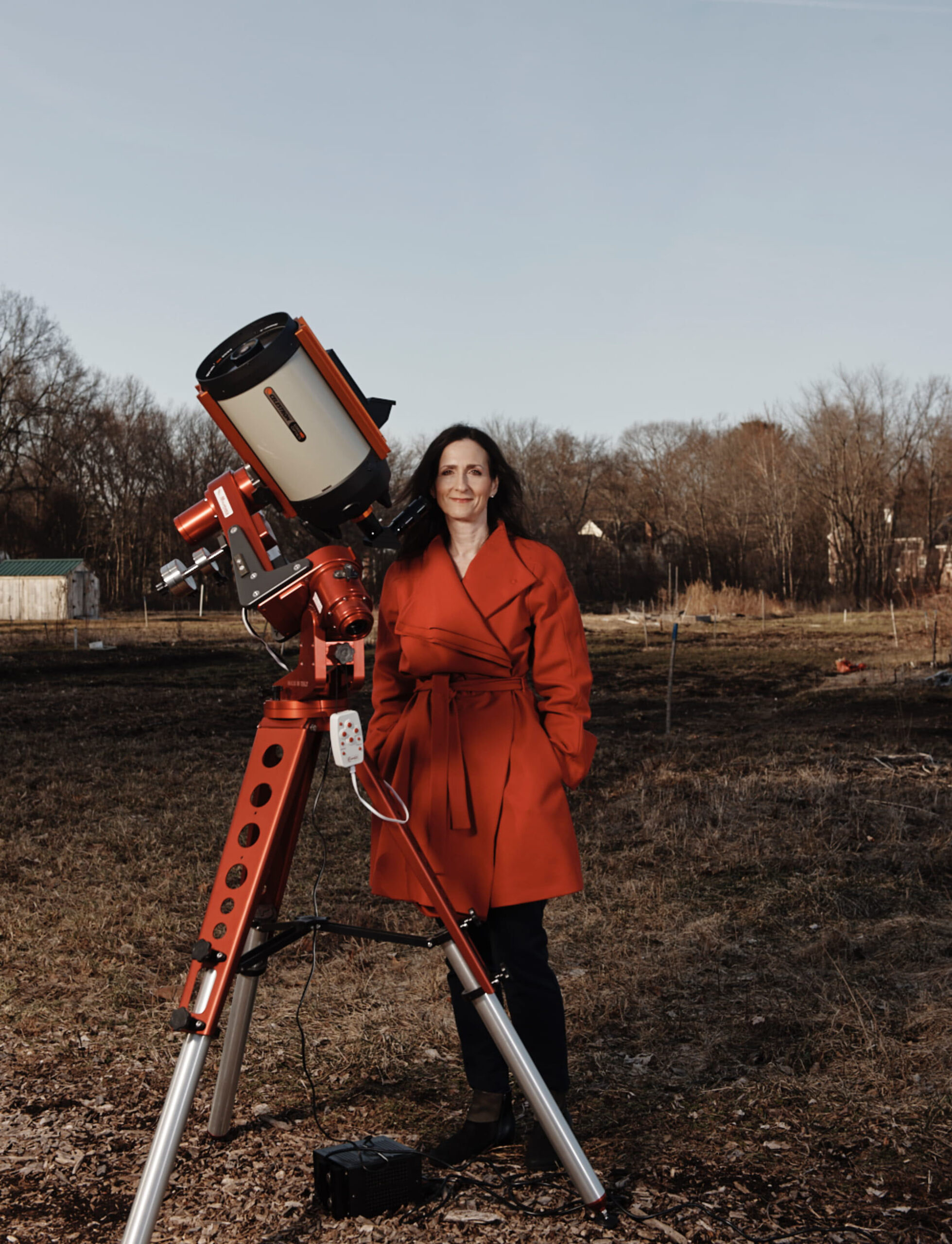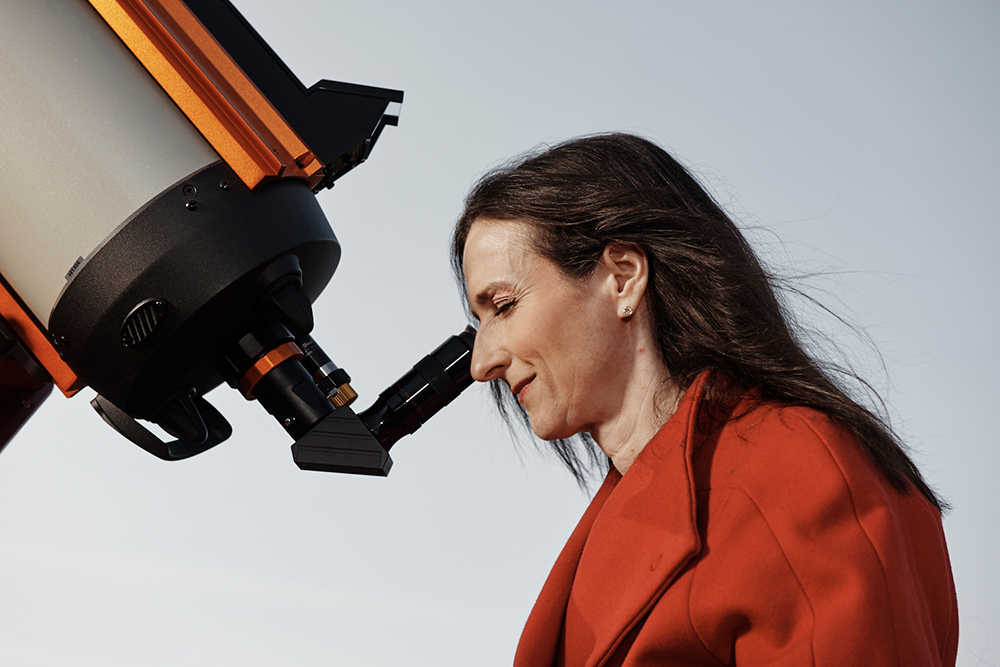A few years ago, Sara Seager (BSc 1994 UC) decided that the colourful, fantasy-travel posters published by the Jet Propulsion Laboratory would be perfect for the hallway just outside her office in MIT’s department of earth, atmospheric and planetary sciences. The posters show fanciful depictions of not only the planets in our own solar system but also of far-away worlds discovered only in the last few decades. (The tag-line for Kepler 16b, a planet that orbits a double-star system: “Where your shadow always has company.”) Whether humans will ever visit these distant worlds is anybody’s guess; even travelling at the speed of light, getting to Kepler 16b would take 200 years. But to Seager, these worlds feel much closer. Astronomers have now catalogued more than 4,500 of these “exoplanets,” some of which may not be too different from our own world. The flurry of discovery has made Seager confident that life, of some sort, is likely to be found beyond our home planet.
“We know that small, rocky exoplanets are common; we know they’re out there, and there are a lot of them,” she told me on a call from her home in Concord, Massachusetts. A photograph of the constellation Orion, the mighty hunter, hung on the Zoom background behind her. “We also suspect the ingredients for life – at least, life as we know it – are very common as well. And water – we think it’s very abundant. So the ingredients for life are there, and the planets are there, and really they just need to come together the right way.”
Seager, 50, has been described by the New York Times as “the woman who might find us another Earth,” while NASA has called her “an astronomical Indiana Jones.” In late 2020, Seager was appointed to the Order of Canada. She is now at the top of her field, but her journey has not been an easy one, as she recounts in her widely praised memoir, The Smallest Lights in the Universe, published last year. There has been love, and also loss, and – at the risk of giving away the book’s ending – love once again.

Born and raised in Toronto, Seager fell in love with the stars after a camping trip to Bon Echo Provincial Park, in rural eastern Ontario. She knew about the stars from books, of course, and from visits to the McLaughlin Planetarium; and she had glimpsed them in a modest way even from light-polluted Toronto. But she had never seen them like this. “It was just so shocking to me,” she recalls. “It was so incredible and so touching – and I wondered why no one had told me about it.”
A second life-changing moment happened as she was cutting across U of T’s St. George campus one day, on her daily trek from her mother’s home in the Annex to her high school, Jarvis Collegiate, on the other side of Yonge Street. She happened to see an advertisement for a campus-wide open house. That weekend, she headed to the astronomy department, at that time housed in the upper floors of the Burton Tower. She emerged from the elevator and saw a table staffed by a professor and some students; they were handing out pamphlets and talking about the stars. Suddenly, it clicked. Astronomy was an actual thing you could study; there were people who had made a career out of it, and she could do that too.
Though her classes were challenging, she has fond memories of her time as an undergrad at U of T, where she majored in math and physics, but also learned about astronomy at every chance. She recalls that “the opportunities for undergrad research were really great.” For Seager, that included two summers spent studying variable stars – ones that grow brighter and dimmer over time in a regular cycle – at the David Dunlap Observatory, just north of the city. She also served as president of the Royal Canadian Institute’s Youth Science Academy.
Before heading to Harvard for graduate school, Seager was determined to have the adventure of a lifetime, far from Toronto’s urban bustle. She joined the Wilderness Canoe Association and prepared for a two-month expedition in Canada’s Far North. It was through the club that she met Mike Wevrick, a young man with a beard and a “mop of ginger hair,” as she put it in her memoir. They married in 1998. By that time, they were already living in Massachusetts, where Seager was hard at work on her PhD – but they came back to Toronto for the wedding, holding a small ceremony in U of T’s Hart House.
Seager’s supervisor at Harvard was Dimitar Sasselov, who had earned his PhD in astronomy from U of T in 1990. Her dream of becoming an astronomer was taking shape. Yet she often felt that she didn’t quite fit in. As an undergrad, even if she had trouble making friends, she had the familiarity of her home city to fall back on. “Graduate school,” she writes in her memoir, “made it harder for me to imagine my way out of my solitude.” She watched her fellow students “the way biologists might observe a family of apes. They formed bonds with each other, but I couldn’t figure out how or when.”
But she had Mike, and a few years later she had two sons as well. Work was challenging, but at least she was contributing to a burgeoning field, one with plenty of room for discovery. When Seager started at U of T in 1990, the only planets that astronomers were certain of were the nine that circled our own sun (Pluto had not yet been “demoted”). Soon, however, the hunt for exoplanets began to heat up. The main challenge in observing a planet in a distant solar system is that its feeble light is overwhelmed by the light of its host star. So astronomers found workarounds. First, they learned how to infer the presence of these planets via the gravitational tug they exert on their star. Later, many hundreds of exoplanets were found using the Kepler Space Telescope, which was able to detect the regular dimming of distant stars as an unseen planet passed in front.
When you lose someone their dying doesn’t stop with their death. You lose them a thousand times in a thousand ways. You say a thousand goodbyes
Initially, no one knew how important this new field would be. “At the time, it was quite risky because there were only a few planets known, and many in the community weren’t sure if they were planets,” Seager recalls. “But by the end of the 1990s, exoplanets were here to stay.”
Seager has investigated many different kinds of these distant worlds. Some of them, she’s found, have both Earth-like properties while also resembling a gas-giant planet, such as Jupiter. Composed mainly of hydrogen and helium, these hybrid planets are called “gas dwarfs.” She has also studied the atmospheres of these planets, developing techniques to analyze their chemical composition from the feeble light astronomers are able to collect from them. Her work on exoplanet atmospheres earned her the Helen B. Warner Prize from the American Astronomical Society in 2007, and the Sackler Prize in the Physical Sciences in 2012. She is also interested – not surprisingly – in whether anything might be alive on any of these worlds, and if so, what evidence of it astronomers might be able to detect, perhaps by looking for unusual chemistry in a planet’s atmosphere. This is known as the hunt for “biosignature gases.” Seager is developing computer models to simulate all manner of possible planetary atmospheres, to see what combinations of gases might hint at life down below.
Further recognition followed. Seager was a tenured professor at MIT by her mid-30s; she was awarded a MacArthur “genius” fellowship a few years later. But her intense commitment to her work took a toll; as she relates in her memoir, she and Mike were drifting apart. And then things got worse. They learned that Mike was suffering from a rare type of intestine cancer. He died just a few days after Seager’s 40th birthday. His passing left her distraught and disoriented: “When you lose someone,” she writes in The Smallest Lights, “their dying doesn’t stop with their death. You lose them a thousand times in a thousand ways. You say a thousand goodbyes. You hold a thousand funerals.” With the help of a group of local women who had also lost their husbands – she calls the informal club the Widows of Concord – she found the strength to carry on.
***
How can one get a better look at an exoplanet? One obvious idea – obvious on paper, at least – is to somehow block out the light from the host star. For more than a decade now, Seager has been part of a team pushing for a project called Starshade – an ambitious venture that would see a large, flower-shaped disk, perhaps 30 metres across, launched into space. It would work in tandem with a space-based observatory, such as the planned Nancy Grace Roman Space Telescope. The telescope would aim at a particular star, while Starshade, positioned strategically some 30,000 kilometres away but exactly in line with the star, would block out the star’s light, revealing the adjacent planet. (Why the unusual shape? Because, physicists have shown, a sunflower-like shape minimizes the amount of diffracted light, yielding the sharpest image.) Starshade would be costly, of course. Seager is hopeful that the project is reasonably high on NASA’s list of priorities – but U.S. astronomers are currently in the middle of a once-per-decade project review and it remains to be seen which proposals get the green light. Seager is hopeful. “I’m going to do my very best to make Starshade, or something like it, a reality.”
While Seager’s focus has been the search for habitable worlds beyond our solar system, she also believes there are potential discoveries to be made closer to home. Last fall, she was part of the team that claimed to have detected the chemical phosphine in the atmosphere of Venus. While that claim is still being scrutinized, it seems that something unusual is happening in the planet’s clouds. (On Earth, phosphine is typically associated with microorganisms, but the team acknowledged that the gas might be created by some unknown chemical process.) Whatever is going on, it was enough to spark the interest of Breakthrough Initiatives, a group established by tech billionaire Yuri Milner. The organization recently provided funding for Seager to lead a planned project to study Venus’s atmosphere in more detail. Whatever they find on Venus, Seager is certain the investigation will be an invaluable warm-up for the future study of exoplanet atmospheres and any signs of life they may harbour.
Seager is a popular draw on the science lecture circuit, and in 2013 the Royal Astronomical Society of Canada, a nation-wide collective of amateur astronomy clubs, asked Seager if she would speak at their annual general assembly, to be held that summer in Thunder Bay, Ontario. She eagerly accepted – and that’s where she met a tall, handsome man named Charles Darrow. Like Seager, Darrow was a long-time night sky enthusiast, though he was happy enough to pursue it as a hobby, gazing at the stars from his cottage on Georgian Bay. With Darrow in southern Ontario and Seager in Massachusetts, their relationship began via phone calls and Skype. “We were pioneers of virtual dating,” Darrow jokes. They married in 2015.
While Seager’s research has focused on distant stars and planets, she has also discovered things about herself – including the very recent realization that she is autistic. The revelation came following a 2016 New York Times Magazine profile in which the reporter described Seager’s solitary nature, her disinterest in small talk, and her ability to latch onto every new project with laser-like intensity. A friend whose wife is an autism specialist emailed her after reading the article. Seager’s first thought, as she writes in her memoir, was that she was “too old not to know such a basic fact” about herself – but she consulted with a specialist, who soon confirmed it. “It was a huge relief,” she recounted over Zoom. “I’m still awkward and different, but I’m happy to have the diagnosis.” She says she’s often approached by young scientists, especially women, who tell her about their own concerns about fitting in, as a result of being diagnosed with Autism Spectrum Disorder. Seager does what she can to encourage and support them. She also believes her condition has helped her excel in science. “I’m so good at my job, probably because I have autism.”
Our conversation turns once again to the stars. Through all the highs and lows, they have been there. They will always be there, instilling awe and providing a measure of solace. “It just somehow feels comforting,” she says. “It feels wonderful, to know that there’s something bigger than all of us.”




9 Responses to “ The Search for Another Earth ”
Most enjoyable. A fascinating individual, a fascinating subject, and a very well written article by Dan Falk.
If geochemistry can merge into biochemistry on Earth (metabolism + membrane + memory = life) then I think it's a high statistical probability that it can do so on some exoplanets. Good luck, Dr. Seager.
This is a very well written article about a superstar U of T alum! I studied astrophysics in a U of T course in 1972 after completing a year of engineering. I went on to study medicine at U of T, graduating in 1977, and became a family doctor.
I have had a lifelong interest in the stars and in the possibility of the existence of other life in the universe. I congratulate Dr. Seager on her stellar accomplishments and I look forward reading her book. I wish her luck with setting up Starshade and with her atmosphere studies. She is an inspiration to so many, and her work with others who have Autism Spectrum Disorder is most commendable.
Wonderful and inspiring! I often think as I view the stars that there must be life of some kind in the galaxy besides us. I'll be watching with anticipation and hope as Sara Seager's research continues.
Thank you for this excellent article. As a U of T astronomer, I knew Sara well. Just two days ago, I heard her give a very well-received lecture to a large group of skilled amateur "citizen scientist" astronomers in the U.S. about her work and how they could collaborate with her. She is a super science communicator, as well as a super scientist.
A well written article. I especially admire the tenacity and ambition of the researcher to explore the possibility of life elsewhere.
However, I think we have more than enough problems on this planet to address before we can invest millions of dollars, as well as the time and energy of talented researchers, into exploring extraterrestrial existence.
We face a climate crisis of unprecedented proportion that is already wreaking catastrophe globally, particularly on the poorest and most vulnerable populations and ecosystems. It is expected to get a lot worse if we don't direct most of our resources (money, talent, time and energy) to addressing the consequences of this crisis.
We need to stop this obsession with "life elsewhere" and urgently shift our focus on the well-being of all life on this planet now and for the future generations.
@Roger: I understand your point. However, I think you undersell the value of studying other worlds, even and perhaps especially hostile ones. For example, we learned of the existence of the greenhouse effect from Venus and about nuclear winter from Mars. These are examples of comparative planetology that aid in our appreciation of the delicate knife’s edge upon which our own planet’s equilibrium is poised.
The “millions of dollars” invested in this pursuit is a small fraction of global wealth, much of which is sunk into far more destructive activities than the search for comparable worlds elsewhere.
We don't need to search for another Earth. What we need to do is take better care of the beautiful Earth we already have.
It was a pleasure to read the article. The question could be, when do we have to start thinking seriously about daring the almost impossible adventure and actually making a journey to other, hopefully habitable, planets?
The number of objects in the universes has always been infinite. There could be infinite planets, and other environments, which will be able to support life as we know it. A belief that such a planet or environment exists is really a statement of fact. How likely do you think it is for an habitable place to be found outside the Earth?